Soil cement stabilization is a proven and effective technique for enhancing the properties of soil to create a durable, cost-effective, and environmentally friendly foundation for various infrastructure projects. Merging the strength of cement with the flexibility and accessibility of native soil, this method provides an essential solution for construction professionals seeking improved soil stability and performance. As we face ever-increasing demands on our built environment, the role of soil cement stabilization as a reliable and sustainable construction approach is becoming more vital than ever.
In this informative article, we will delve into the benefits and best practices of soil cement stabilization for infrastructure projects. From improved strength and reduced permeability to lowered construction costs and decreased environmental impact, we'll explore the various advantages soil cement stabilization brings to projects of all sizes. Additionally, we'll share expert insights and tips on the most effective methodologies for implementing soil cement stabilization in your projects, ensuring optimal results and long-lasting performance.
Join us as we uncover the full potential of soil cement stabilization and how its implementation can elevate the quality and sustainability of your infrastructure projects. With Terra-Firma Stabilization & Reclamation as your partner in Asphalt Pulverization, Soil Improvement & Modification, and Full-Depth Reclamation, you'll gain the confidence and knowledge to integrate soil cement stabilization seamlessly into your construction process, ensuring unparalleled results and long-term success.
The Benefits and Best Practices of Soil Cement Stabilization for Infrastructure Projects1. Understanding Soil Cement StabilizationThe first and most important consideration for soil stabilization is understanding the soil composition and properties. The composition of the soil determines its strength, permeability, and other properties that affect its stability and durability. Different types of soils require different approaches to stabilization, and the methods used must be tailored to suit the soil composition and properties.
For example, clay soils are generally more challenging to stabilize than sandy soils because they have a higher shrink-swell potential and can be more susceptible to cracking and erosion.
Before undertaking a soil stabilization project, it is essential to conduct thorough soil testing and analysis to determine the soil's composition and properties. This analysis will help identify potential issues during the stabilization process and determine the best approach. Some common tests used to analyze soil properties include sieve analysis, Atterberg limits tests, and compaction tests.
2. Key Benefits of Soil Cement StabilizationThe popularity of soil cement stabilization can be attributed to a host of benefits that the technique offers. These include:
a. Increased Strength and Durability: The stabilized soil exhibits improved load-bearing capacity and resistance to deformation, providing a long-lasting foundation for infrastructure projects.
b. Reduced Permeability: Soil cement stabilization decreases the soil's permeability, reducing the risk of water infiltration, which can accelerate erosion and compromise the foundation's integrity.
c. Lower Construction Costs: Owing to the use of locally available native soil, soil cement stabilization can lead to significant savings in material and transportation costs.
d. Environmentally Friendly: The process reduces the need for material excavation and promotes the reuse of existing resources, minimizing environmental impact on the project site.
3. Best Practices for Implementing Soil Cement StabilizationTo ensure the success of soil cement stabilization projects, consider the following best practices:
a. Conduct Thorough Soil Analysis: A comprehensive analysis of the native soil on the project site is crucial to understanding its properties and determining the most appropriate cementitious materials and mix proportions. This may include particle size distribution, plasticity, moisture content, and pH level evaluations.
b. Optimize Mix Design and Proportions: Identifying the optimal mix design and proportions of cementitious materials for the specific soil type will significantly impact the performance of the stabilized soil. Engage experienced professionals to fine-tune the mix design and adhere to industry standards and guidelines.
c. Monitor and Control Quality: Implement a rigorous quality control plan that includes regular testing and analysis throughout the construction process to ensure consistency, performance, and compliance with project specifications.
4. Techniques for Soil Cement StabilizationVarious techniques can be employed in soil cement stabilization projects, with the most common methods being:
a. In-Situ Stabilization: This technique involves mixing cementitious materials with native soil directly on the project site using specialized equipment such as rotavators or reclaimers. In-situ stabilization is ideal for large-scale projects where transporting large volumes of material is impractical or cost-prohibitive.
b. Central Plant Mixing: In this method, soil and cementitious materials are transported to a centralized processing facility, where expert technicians carefully control the mixing process to ensure optimal results. Central plant mixing is suitable for smaller projects with more stringent quality standards and material consistency requirements.
c. Deep Mixing Method: For projects requiring substantial subgrade improvement, deep mixing is a technique that involves injecting cementitious materials into the soil at significant depths. This method stabilizes the deeper soil layers, providing enhanced support for heavy loads and extended performance lifecycles.
Building a Strong Foundation with Soil Cement StabilizationSoil cement stabilization offers a versatile and sustainable solution for improved soil performance in infrastructure projects. By understanding the benefits, best practices, and techniques associated with soil cement stabilization, construction professionals can gain a competitive edge and deliver projects that are more resilient, long-lasting, and environmentally responsible.
As experts in Asphalt Pulverization, Soil Improvement & Modification, and Full-Depth Reclamation, Terra-Firma Stabilization & Reclamation is uniquely positioned to assist with your soil cement stabilization needs. Our team can provide the guidance, resources, and expertise necessary to ensure the success of your project, from initial concept to final completion.
Contact us today to discuss how our comprehensive
soil cement management services can support your next infrastructure project, and let Terra-Firma Stabilization & Reclamation help you build a solid foundation for enduring success through soil cement stabilization.

